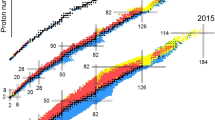Abstract
The paper is dedicated to a very interesting and rapidly developing field of nuclear physics—the generation and study of exotic nuclei in the vicinity of the driplines. The history of this field is presented with methods of obtaining such nuclei in the accelerators of the world’s leading research centers—the European Organization for Nuclear Research (CERN) in Switzerland and the Helmholtz Center for Heavy Ion Research (GSI) in Germany. The structure of the nuclei, as they change greatly approaching the driplines of neutron and proton stability, is given, as well as the results of experimental research of neutron- and proton-rich nuclei and the formation of neutron halos in isotopes of helium, lithium, beryllium, and boron, strongly enriched with neutrons. Information on medical applications of radionuclide beams is presented.
Similar content being viewed by others
References
P. G. Hansen, A. S. Jensen, and B. Jonson, “Nuclear halos,” Annu. Rev. Nucl. Part. Sci. 45 (1), 591–634 (1995)
B. Jonson, “Light dripline nuclei,” Phys. Rep. 389 (1), 1–59 (2004).
L. V. Chulkov, B. Jonson, and M. V. Zhukov, “Light nuclei in the vicinity of the dripline and beyond” Eur. Phys. J. A 51 (8), 97–120 (2015).
M. V. Zhukov, B. V. Danilin, D. V. Fedorov, J. M. Bang, I. J. Thompson, and J. S. Vaagen, “Bound state properties of Borromean halo nuclei 6He and 11Li,” Phys. Rep. 231 (4), 151–199 (1993).
M. Pfützner, M. Karny, L. V. Grigorenko, and K. Riisager, “Radioactive decays at limits of nuclear stability,” Rev. Mod. Phys. 84 (2), 567–619 (2012).
M. Durante, P. Indelicato, B. Jonson, V. Koch, K. Langanke, U.-G. Meissner, E. Nappi, T. Nilsson, T. Stoehlker, E. Widmann, and M. Wiescher, “All the fun of the FAIR: Fundamental physics at the Facility for Antiproton and Ion Research,” Phys. Scr. 94, 033001 (2019).
M. J. G. Borge and B. Jonson, “ISOLDE past, present and future,” J. Phys. G. Nucl. Part. Phys. 44 (4), 044011 (2017).
A. S. Fomichev, L. V. Grigorenko, S. A. Krupko, S. V. Stepantsov, and G. M. Ter-Akopian, “The ACCU-LINNA-2 project: The physics case and technical challenges,” Eur. Phys. J. A 54 (6), 97–118 (2018).
Author information
Authors and Affiliations
Corresponding author
Additional information
Björn Jonson is a Professor in the Department of Physics, Chalmers University of Technology, Göteborg, Sweden.
Russian Text © The Author(s), 2019, published in Vestnik Rossiiskoi Akademii Nauk, 2019, Vol. 89, No. 6, pp. 571–581.
Rights and permissions
About this article
Cite this article
Jonson, B. Exotic Nuclei. Her. Russ. Acad. Sci. 89, 221–230 (2019). https://doi.org/10.1134/S1019331619030043
Received:
Revised:
Accepted:
Published:
Issue Date:
DOI: https://doi.org/10.1134/S1019331619030043




